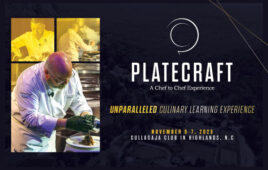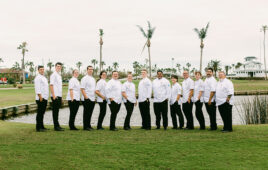Hang around in this business long enough, and you’ll come across some amazing “small world” coincidences. The latest for me was to find out there’s a rising star among club chefs, now working at a prestigious new club in Charlotte, N.C., who grew up literally in the backyard of my club, and in fact used to sneak onto Merion’s grounds as a kid to go sledding in the wintertime. As an added coincidence, Paul Verica, Executive Chef at The Club at Longview, now works with another contributing writer to Club & Resort Business, Don Vance, who is the club’s Chief Executive Officer
Coincidence aside, by far the most interesting part of Paul Verica’s story is how truly passionate he is about food. Paul stayed away from the club industry initially, because of a preconceived notion that the cuisine was dull and unimaginative. But after taking the drive that leads up to Longview’s impressive “Old World European-style” clubhouse, and seeing its beautiful, Nicklaus-designed golf course, Paul realized this was an opportunity he needed to pursue. His enthusiasm only grew further after he learned he would be encouraged to create food for the members that would rival the best to be found in the fast-growing Charlotte area.
Thanks in large part to the innovative use of ingredients grown in a garden just outside his kitchen door, Paul is well on his way to adding a strong F&B distinction to how The Club at Longview already stands out from a golf and architectural perspective. As I listened to the out-of-the-box thoughts of this imaginative chef, I was proud of how this "kid from my backyard" now contributes to our industry.
Q Paul, your menu separates classic club cuisine dishes from feature items on what you call your “market menu.” What’s behind this strategy?
A We are still a very young club (we opened in 2003), and we have a pretty diverse membership—our average age is in the upper 30s, and among our 240 member families, we have over 400 children. So from the start, we’ve needed to try to be many things to many people.
When we sent out a membership survey, the comment I saw the most was to change the menu more often, and add more variety. Once I saw that, I was convinced that a “market menu” approach was the direction we needed to take. The concept behind it is that whatever I can secure from the farmers market and family farms is what we will showcase for two weeks. We have built a great network of farms that raise fruits, vegetables, rabbits, chickens, turkeys, lamb, pork, beef and ostrich for us—no fish farmers yet, but when I find one I like, we’ll start using them as well.
At the same time, though, I knew that, even after just two years, we had already established dishes we couldn’t take off the menu. So I also created a “Longview Classics” side of the menu, with a wide variety of dishes that have been consistent winners. There is fried chicken and meatloaf, right next to a Thai-inspired lobster lettuce wrap and macadamia nut-crusted sea bass.
Q How has this all been received?
A The impact has been tremendous. Since we started the market menu program about six months ago, we’ve seen weekend cover counts increase on average by 15%, and almost a $3.00 increase in check averages. Yes, the increase in check average is fueled in part by higher menu prices, which are driven by higher ingredient prices—but if you want the best, you have to buy and grow the best. And when our members taste that in the food, they do not mind paying a little bit more.
I know that our membership appreciates the quality and freshness we are now providing and to be quite honest, I think some of them enjoy the “bragging rights” that come with a program like this. I am a very visible chef—I spend a lot of time in the dining room talking with and learning about our membership and chatting with their guests, because I feel it is very important that they know I am here for them. They love to hear me talk about what items we are growing and how we just picked the tomatoes they’re about to eat, or that the herbs encrusting their tenderloin were picked fresh that afternoon from our garden. It contributes greatly to the “wow” factor.
Q You mentioned the garden you’ve established on the property, which has become an integral part of the culinary statement made through the “market menu.” Can you tell us how this came about?
A I was fortunate enough to spend some time in France, studying under the tutelage of two great chefs. At both of those establishments (La Cote D’or and L’Arpege), we received our produce fresh everyday, and most often twice a day. Most of my career I have been yearning to cook like that again: simple food, in rhythm with the seasons, and in tune with nature.
To do that, we need to try to “go back in time” with how we cook and treat our ingredients, getting back to cooking seasonally, buying locally as much as possible, and “eating with a conscience"—buying from farmers and vendors that support sustainable farming practices and focus on organic farming. It is time to stop putting “stuff” in our food so that it no longer tastes like what it is intended to be. And at Longview, we take that a step further, growing many things on property. We are not certified organic, but we follow organic practices.
Q What specific impact have home-grown organics had on food quality for you and your staff?
A The funny thing is, as we chefs and culinarians become more concerned about where our food is coming from and how it is treated, we can actually find that it’s easier to cook food with great ingredients. For example, I had a local farm, Grateful Growers, bring me a whole pig to roast for our recent member/guest tournament, and I knew I couldn’t get a fresher product—I mean, it was still walking three days earlier. That told me a lot about how I needed—and didn’t need—to cook it. I didn’t need to worry about building up layers of flavor in the pig, because the farm had already done that for me, by feeding it a great diet of grass, worms and acorns. And it had already developed great marbling from being able to roam around the 10-acre farm.
The same now goes for our salads; we clip our mixed greens each day before lunch and then again before dinner. On a busy night, we often pull and cut crops to order. To me, that is top quality, and beyond fresh.
Q How much are you harvesting from your kitchen garden, versus what you purchase from vendors?
A Our harvest varies from season to season. We are very lucky to be in the Carolinas, with a great climate that allows for growing most of the year. We are taking steps to ensure that we will able to grow through the winter this year—just this week, my F&B Director [Mike Beveridge] and I built a cold frame to house our fresh herbs. We hope this will let us harvest lettuces all winter, as well as give us a huge jump on spring crops.
The biggest year-round impact that the garden has is for specialty items and fresh herbs—we have not bought fresh herbs in well over a year. For specialty produce, I try to focus on small plantings of a variety of items; this works very well for us, because of how we change our market menu every two weeks. Right now, for the late fall season, we are growing turnips, Brussels sprouts, carrots, radishes, salad greens, some Asian salad and cooking greens, fennel, cardoons, romaine, bibb lettuce, Swiss chard, garlic and kale.
That may sound like a lot, but it’s really not. I try to grow items so they last for about a month or so, and I also space items a week or two apart. So one week I will have turnips, then I won’t for two more weeks, then they come back again. It is a lot of extra work, but well worth it. When I was talking about the workload on my blog the other day (www.the clubatlongview.com; click on Social & Dining at top, then on The Garden Blog at left), I related it to raising children. Both are a ton of work, but so worth it—and the nicer thing about plants is that they do not talk back.
Overall, about 15 to 20% of the produce that we use on an annual basis is now grown here at the club. When you add what we purchase from local farmers, we could take that number to 45 or 55%, and even higher in the peak growing seasons. I hope to increase it in the coming year by making better use of the space I have in our garden, which is along a service driveway just outside our kitchen door. And by the way, we’ve found an unexpected benefit from having the garden in this location—the noise from our chillers scares a lot of the intruding rabbits and other “uninvited diners” away.
Q Speaking of ingredient costs, I noticed that when you sent recipes to be included with this article, they all included a cost analysis, with very specific per-ingredient breakdowns and calculations. Can you speak to the benefits of executing this process on a consistent basis?
A As much as I love the creative side of what we do, I also love the numbers side and understanding the “how and why.” There are many benefits to costing out all of our recipes, and the one that I feel is most important is that it teaches my staff the important concept that “food is money.” This is very important for them to understand as they move forward in their careers; they will look at products differently when they know the costs associated with each of them. I also feel it will make them less likely to waste products, when they can relate tossing out half a pepper to dollars that could be used for their next raise.
Knowing the costs also helps to keep me on top of my vendors and look at our internal processes, to make sure we are being as efficient and effective as we can be. For example, we used to buy all of our fish in whole or fillet form, and butcher them down ourselves. While this to me was the ideal way to do things, it led to some waste and quality issues, because as a young club our business volumes can be inconsistent—we can do 60 covers on a Friday night and then 20 on Saturday. Since the last thing I want to do is sell a bad product, let alone waste a product, that led me to look into options for pre-cut, “cry-o-vac” fish. The price per pound was a little bit more, but if we monitor our product levels, purchase what we need when we need it, and store and handle the product properly, we can increase our shelf life dramatically. At the same time we are trimming waste.
And of course the biggest benefit of costing all of our recipes is that I can make sure we are working towards achieving our food cost goals, which is a constant struggle, with multiple factors working against us. Having standardized recipes and sharing this costing information with my staff, to give them a sense of ownership and understanding, again gives us another tool to use in working to achieve our goals.
Q Beyond your regular dining-room service, what are you doing in the way of cooking classes, and how are you incorporating what you have in your garden into them?
A I have held monthly cooking classes for the last two years, and it’s been a lot of fun. I have brought vendors in to do show-and-tell type classes, with good response, and some of the ethnic cuisine classes we have done have also gone over very well.
The most popular class was when we did our twist on “Dream Diners” a few months ago. The members came in and prepared four meals, and then took them home for future use. The response was so strong that I am planning to have one of these classes in each quarter next year. We will tie in our market menu concept and prepare meals that are in tune with the seasons. We often try to incorporate the garden into these classes, by having members go and pick fresh herbs and vegetables to use during the class.
We have also done several children’s cooking classes with great response. The first one was kitchen basics—we toured the kitchen, learned about the different equipment and basic sanitation, and also held a little food identification class while touring the garden. The children were able to fill up a small basket of tomatoes, peppers, herbs and cucumbers to take home with them. Breakfast and pizza classes have also gone over big with our younger members.
Q How about off-premise catering and takeout sales; are there some especially good opportunities in these areas, with the beautiful homes that surround the club?
A Takeout business has been a great revenue stream for us, especially in the summer and around the holidays. At Thanksgiving and Christmas, we offer a selection of fully prepared meals that members can order for their family holiday feasts. This year for Thanksgiving, we fed over 200 people just with to-go meals. The revenue was great, and it freeds up more space in our dining room, so we could maximize the number of covers that we did for the buffet.
With the young membership that we have, I have also found that we can do a good amount of baking for school fundraisers and events. Members call and tell me how they have ‘volunteered’ to prepare something for their children’s school, and were wondering if we could help. Of course, we are always happy to oblige with pies, cakes and cookies; not only do these have great profit margins, just as importantly they add to the levels and layers of service that we are providing.
We have also dabbled in off-premise catering over the last two years to some success. It is a great revenue stream and there seems to be some demand for it. At this point we are not fully equipped to handle a large number of inquiries. Down the road, when we are at our full membership, it may be something that we’ll pursue a bit more actively. We do encourage, and do a fair amount of volume, with “stop and drop” catering—this is great for us because it doesn’t involve any extra staff or equipment or take up any more of our kitchen space, which is at a premium.
Q Do you also see any potential to turn your garden into a retail opportunity?
A In the coming year, one of my big projects will be to explore the retail food sales side. We often have requests from members who want to purchase our salad dressing or are having a cookout and want to order some fresh-cut steaks or fish through us. It is not a ton of volume, but I think if we package it properly to let members know that we can do these things for them, they will buy it, and it could become another revenue stream that wouldn’t add very many additional expenses. And especially with our newly redesigned web site, I think this could be another great way to showcase the garden, by producing sauces, marinades, salsa and other products with herbs and vegetables that we grow in the garden.
Think of it as “Longview’s Own”… In fact, if it really drives revenue, it may help me negotiate for more land to farm.
Q So with all of this going on, Chef, how would you sum up your ability to achieve the goals that you’ve set for yourself at Longview?
A The last two and half years have been a tremendous learning experience for me, having never worked in a club setting before. And with our club being so young, I have seen and learned a ton.
I think anyone who drives into the club and sees the clubhouse for the first time has great expectations before they even get out of their car. From our ownership group all the way down, the focus is on having the highest quality product, the greatest level of member satisfaction and on becoming the best club in the city, if not one of the best in the country. Our golf course has been consistently rated in the top 20 in the state since it opened four years ago. People come here to play our great course, and I want them to leave thinking about our great food as well as the course.
That puts a lot of pressure on all of the staff to perform, and I stress to my staff all the time, there is no margin for error. We are not here just to cook and put food on a plate, we are to strive for excellence, and anything less is unacceptable. Whether we are preparing a multi-course chef’s table or a burger, it is to be the best.
The major key to our success as a food and beverage operation in the future will be to not only continue to listen and respond to our members, but also to recognize that as the club grows, the members’ wants and needs will change. So we as a team will have to be open and flexible to evolve.
I have been told that I am extremely flexible for someone in my position, and I will continue to be that way; I want my members to know that all they ever have to do is ask. Sure, I would love it if we never sold another club sandwich or order of fish and chips—but I am a realist and know we have a business to run. And the way to run that business is to cater to the captive market made up of our members and guests.
One of the questions I ask potential job applicants, in fact, is “What do you say if a member asks for ice cream on their steak?” The right answer has two parts: What temperature would you like that cooked, and what flavor ice cream? If I get that answer or something close to it, I know that the applicant gets it and will have the right attitude.
Before I came here, I had been in the hospitality business for over 15 years, working in hotels, resorts and independent restaurants. To be frank, I never thought I would work in a club, because I had so many preconceived notions about what “club cuisine” was—and wasn’t. It turns out I was wrong—I have spent more time developing myself in the last two and half years, from both the creative and business perspectives, then I did in the five years prior.
And the added bonus is how much more customer service-oriented the club industry actually is. I love being able to develop relationships with our members. I have never been in an environment where I have been able to introduce so many new foods and food concepts to people. It’s very rewarding to get members to try things they would never think of trying themselves. These things would never happen in a hotel restaurant. C&RB





